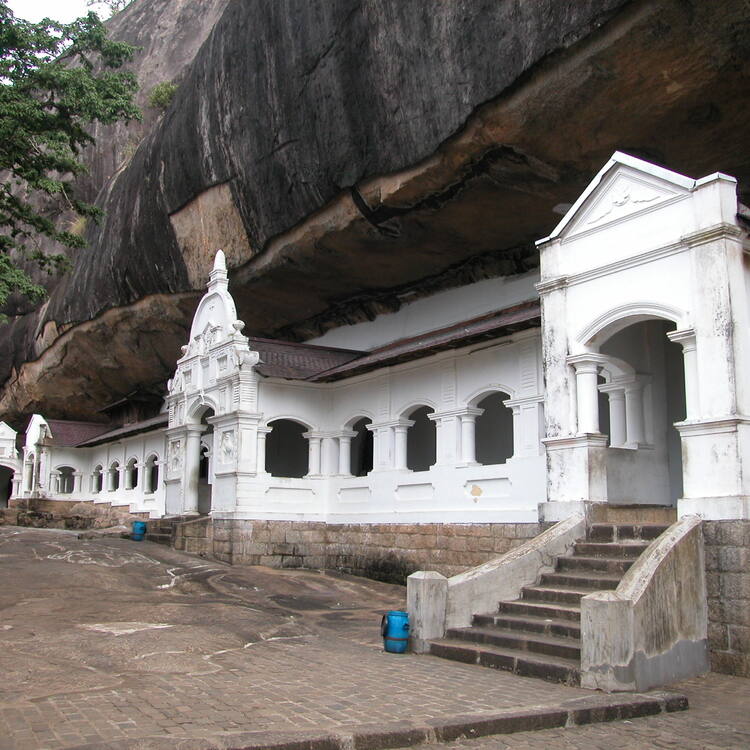Rangiri Dambulla Cave Temple
A sacred pilgrimage site for 22 centuries, this cave monastery, with its five sanctuaries, is the largest, best-preserved cave-temple complex in Sri Lanka. The Buddhist mural paintings (covering an area of 2,100 m2 ) are of particular importance, as are the 157 statues.
Outstanding Universal Value
Brief synthesis
Located in central Sri Lanka, the Rangiri Dambulla Cave Temple is a living Buddhist site that is focused on a series of five cave shrines. Inhabited by forest-dwelling Buddhist monks since the 3rd century BCE, these natural caves have been transformed continuously throughout the historical period into one of the largest and most outstanding Buddhist complexes in the Southern and South Eastern Asian region, showcasing innovative approaches to interior layout and decoration. In keeping with a longstanding tradition associated with living Buddhist ritual practices and continuous royal patronage, the cave shrines underwent several renovation and refurbishing programmes before assuming their present interior forms in the 18th century. The vast internal spaces of the cave shrines are not compartmentalized, but are spatially differentiated by a deliberate and subtle arrangement of polychrome sculpture of exceptional craftsmanship and decorated with brilliant compositions of mural paintings. This spatial hierarchy and purposive interior layout devoid of physical divisions lead the devotees systematically through the spaces from one ritual function to the next. The site is remarkable in the Buddhist world for its association with the continuous tradition of living Buddhist ritual practices and pilgrimage for more than two millennia.
Criterion (i): The monastic ensemble of Dambulla is an outstanding example of the religious art and expression of Sri Lanka and South and Southeast Asia. The cave shrine, their painted surfaces, and statuary are unique in scale and degree of preservation. The monastery includes significant masterpieces of 18th-century art in the Sri Lankan school of Kandy.
Criterion (vi): Dambulla is an important shrine in the Buddhist religion in Sri Lanka, remarkable for its association with the long-standing and wide-spread tradition of living Buddhist ritual practices and pilgrimage for more than two millennia.
Integrity
The property includes all the elements and components related to different facets of creativity that are necessary to express the Outstanding Universal Value of the property, such as the polychrome statuary either moulded with stucco or clay or carved out of the living rock within the cave shrines, mural paintings, and interior layout. The physical fabric of these elements is in good condition and has been preserved to express this value. The property currently does not suffer from any adverse effects of development or other pressures.
Authenticity
The overall form and design as well as the materials and substance of the mural paintings that cover the interior surfaces of the cave shrines and the rock-cut and moulded statuary within the caves have been retained. No interventions have been carried out to change the overall form and design of the interior spaces of the caves, or the location and positioning of sculptures and paintings in relation to their interior layouts. The interior spaces are still being used by pilgrims for ritual Buddhist practices, thus maintaining the original use and function as well as the spirit and feeling of their interior spaces.
Protection and management requirements
The property, which is under the ownership of the Asgiriya Chapter of Buddhist monks, has been declared a Protected Monument under the legal protection of the Department of Archaeology of the Government of Sri Lanka, which administers the Antiquities Ordinance of 1940 (rev. 1998) at the national level. No interventions to the property are allowed without the permission of the Department of Archaeology. Conservation and monitoring of the paintings and polychrome objects are the responsibility of the Department of Archaeology. The monks conduct the daily rituals and are responsible for the general maintenance, protection, and upkeep of the property. Part of the gate collection from foreign tourists visiting the property is used by the monks for these purposes. The area extending up to the edge of entire rock outcrop has been designated a buffer zone under the purview of the Department of Archaeology. The religious character of the property is further safeguarded by the declaration of the whole area around the rock outcrop as a sacred area by the National Physical Planning Department.
The main challenges ahead are conserving the paintings, dealing with the carrying capacity in view of increased pilgrimage mainly during religious festivities, and achieving better results in conservation and regular maintenance. Sustaining the Outstanding Universal Value of the property over time will require taking measures to enhance the management, conservation, and presentation of the property. These include preparing a heritage management framework, a master development plan, and a visitor management plan, and establishing a regular monitoring regime .
State of Conservation (SOC)
by year

Comments